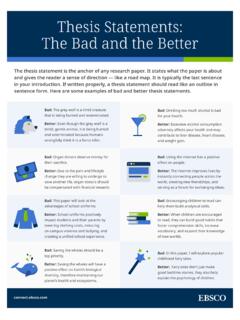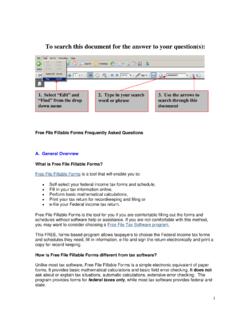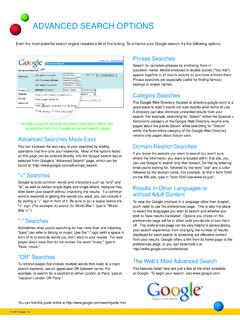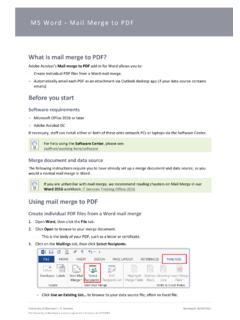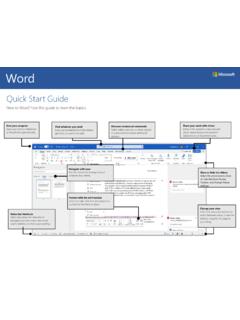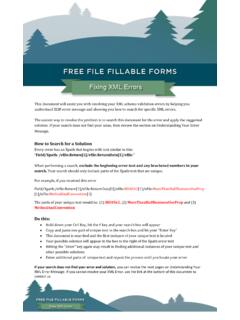Transcription of 7 Steps to the Perfect Pico Search White Paper
1 7 Steps TO THE Perfect PICO SEARCHE vidence-Based Nursing NURSING PRACTICE: 7 Steps to the Perfect PICO Search2 OVERVIEWS earching for high-quality clinical research evidence can be a daunting task, yet it is an integral part of the evidence-based practice process. One way to streamline and improve the research process for nurses and researchers of all backgrounds is to utilize the PICO Search strategy. PICO is a format for developing a good clinical research question prior to starting one s research. It is a mnemonic used to describe the four elements of a sound clinical foreground question (Yale University s Cushing/Whitney Medical Library).In this White Paper , we will explore the importance or evidence-based nursing practice, take a deeper dive into the PICO process and provide an example of the PICO process in action through a case scenario. Whether you are a librarian, a nurse or a nursing student, the chances are good that you will learn something new as you read, 7 Steps to the Perfect PICO Search .
2 WHAT IS EVIDENCE-BASED NURSING PRACTICE AND WHY IS IT IMPORTANT?Evidence-based nursing is a process founded on the collection, interpretation, appraisal, and integration of valid, clinically significant, and applicable research. It is not about developing new knowledge or validating existing knowledge, but rather translating existing evidence so that it can be applied to clinical decision making. The expected standard in modern healthcare systems, evidence-based nursing practice links research and theory to practice, providing clinicians with current, reliable research-driven data to guide patient care has shown that patient outcomes are substantially improved when health care is based on evidence from well-designed studies versus tradition or clinical expertise alone. Better patient outcomes lead to more efficient performance, which is crucial for hospitals with staffing challenges. Evidence-based practice in nursing is using and carrying out nursing practices based on the best available knowledge.
3 Evidence-based practice integrates the nurse s clinical expertise with the best external research evidence, and takes into account patient preferences to deliver quality nursing care. -Victoria Schirm, Director of Nursing Research, Penn State UniversityEvidence-Based PracticeBest External Research EvidenceNurse s Clinical ExpertisePatient PreferencesEVIDENCE-BASED NURSING PRACTICE: 7 Steps to the Perfect PICO Search3 WHAT IS THE PICO PROCESS?PICO is a format for developing a good clinical research question prior to starting one s research. It is a mnemonic used to describe the four elements of a sound clinical foreground question. (Yale University s Cushing/Whitney Medical Library). The question needs to identify the patient or population we intend to study, the intervention or treatment we plan to use, the comparison of one intervention to another (if applicable) and the outcome we anticipate. These make up the four elements of the PICO model: Patient/Problem, Intervention, Comparison and PICO process starts with a case scenario from which a question is constructed that is relevant to the case and is phrased in such a way as to facilitate finding an answer.
4 Once a well-structured question is formulated, researchers will be in a better position to Search the literature for evidence that will support their original PICO question. STEP 1: FORMULATE THE PICO QUESTIONCase Scenario: You are a Registered Nurse working on a Urology unit. One of your patients is a 55-year-old man who is recovering from abdominal surgery specifically a laparoscopic prostatectomy. The patient complains of abdominal pain and nausea. His abdomen is distended, and he has no bowel sounds. The physician suspects a paralytic ileus and confirms the diagnosis based on the combination of clinical features and the next Evidence-Based Nursing Practice Committee meeting, you discuss this case. The committee decides to do a case study to determine if there is evidence to suggest that a simple intervention such as chewing gum post-operatively can prevent a post-operative ileus following abdominal surgery. Based on this scenario, our research question is: In patients undergoing abdominal surgery, is there evidence to suggest that chewing gum post-operatively compared with not chewing gum post-operatively affects post-operative ileus?
5 1. Formulate the PICO Question2. Identify Keywords for each PICO Element 3. Plan the Search Strategy 4. Execute the Search5. Refine the Results6. Review the Literature7. Assess the EvidenceReview the LiteratureAssess the EvidenceRefine the ResultsExecute the SearchPlan the Search Strategy Identify Keywords Formulate the PICO Question7 Steps to the Perfect PICO SearchEVIDENCE-BASED NURSING PRACTICE: 7 Steps to the Perfect PICO Search4 STEP 2: IDENTIFY KEYWORDS FOR EACH PICO ELEMENTP opulation (P) What individual or group are we interested in studying? Intervention (I) What is the action (intervention, treatment) we are considering taking?Comparison (C) To what other action (intervention, treatment) are we comparing the considered action?Outcome (O) What do we anticipate as an outcome? In patients undergoing abdominal surgery, is there evidence to suggest that chewing gum post-operatively compared with not chewing gum post-operatively affects post-operative ileus?
6 PICO ELEMENTSKEYWORDSP (Patient or Population)Patients undergoing abdominal surgeryI (Intervention)Chewing gumC (Comparison)Not chewing gumO (Outcome)Affects post-operative ileusSTEP 3: PLAN your Search STRATEGY Plan a Search strategy by: Determining which database(s) to Search Identifying the major elements of your question Translating natural language terms to subject descriptors, CINAHL Headings, or synonymsInterface: EBSCO host Research Databases Database: CINAHL Complete Search Screen: Advanced Search Fig. 1 CINAHL Complete is just one of the information resources a nursing researcher can utilize to execute a Perfect PICO Search . Considered to be the definitive research tool for nursing and allied health professionals, CINAHL Complete provides fast and easy access to top nursing and allied health journals, evidence-based care sheets, quick lessons and continuing education modules. This database contains full text for many of the most-used journals found in the CINAHL index.
7 With CINAHL Complete, users can access a comprehensive scope of content covering over 50 nursing specialties as well as allied health subjects including speech and language pathology, nutrition, physical therapy and much , words or phrases that mean exactly or nearly the same as another word or phrase, can help expand your Search appropriately. For example: when searching the keyword surgery , you might miss articles that instead describe a patient as postoperative or in recovery . Adding synonyms will help to expand your results to those articles that are still relevant but might not include the words abdominal surgery . These are shown as Search Strategies in the table NURSING PRACTICE: 7 Steps to the Perfect PICO Search5 PICO ELEMENTSKEYWORDSSEARCH TERMSSEARCH STRATEGIESP (Patient or Population)Patients undergoing abdominal surgeryAbdominal SurgeryAbdominal surgeryORSurgeryORPostoperativeORRecover yI (Intervention)Chewing gumChewing GumChewing GumORGumC (Comparison)Not chewing gumO (Outcome)Affects post-operative ileusPostoperative IleusPostoperative IleusORParalytic IleusOR IleusFig.
8 2 STEP 4: EXECUTE THE SEARCHB efore you begin your Search , you will want to ensure the Search Mode is set to Boolean/Phrase. The reason this is important is because this option allows for exact phrase searching. For example, if you searched for the phrase, Heart Disease, the system will Search for records where the two words heart and disease appear together, as a phrase, and not simply records where the two words appear begin your Search , first refer to Fig. 2 above. Each PICO Element (P, I, C, O) will be searched individually using the correlating Search Strategy. After each Search , you will clear the screen and start a new Search before beginning your next Search . P (Patient or Population): Begin your Search with the Patient or Population, which are those patients undergoing abdominal surgery. As mentioned above, to increase your Search results, try adding less descriptive terms that have the same meaning, such as Surgery, Postoperative or Recovery.
9 *Note: Be sure to use the Boolean operator, Or , so that each result contains at least one of these Search terms. Fig. 3 is an example of this Search strategy shown on 3 EVIDENCE-BASED NURSING PRACTICE: 7 Steps to the Perfect PICO Search6 I (Intervention): Start a new Search for the Intervention, which is Chewing Gum or Gum. Be sure to use the Boolean operator, Or . Note the number of results. O (Outcome): You can now conduct a Search for the Outcome, which is post-operative ileus. Add the synonyms paralytic ileus or ileus. your goal is to determine whether chewing gum postoperatively affects postoperative ileus, positively or negatively. Click Search and note the number of results. Combine searches: To complete your Search , you will combine the Population (those patients undergoing abdominal surgery); the Intervention (Chewing gum) and the Outcome (Post-operative ileus/paralytic ileus). By using your database s Search History, you should be able to combine these searches into one Search showing results from all three of your previous 5: REFINE your RESULTSYou can now refine you results by adding limiters.
10 Applying limiters to your Search will allow you to focus your results to the most pertinent and relevant content ensuring that you aren t wasting time wading through content that may not be example, you may wish to limit your results by Date and Type: Published Date Use this option to Search for articles within a specified date range. Evidence-Based Practice You may wish to limit your articles to only those which are evidence-based. When searching an EBSCO host database for example, the Evidence-Based Practice limiter searches the Special Interest field for the value Evidence-Based Practice. Applying this limiter allows you to limit results to: Articles from evidence-based practice journals Articles about evidence-based practice Research articles (including systematic reviews, clinical trials, meta analyses, etc.) Commentaries on research studies (applying practice to research)Should you find that you are left with too few articles by limiting your results to Evidence-Based Practice, you can instead choose any or all of the following publication types:1.
